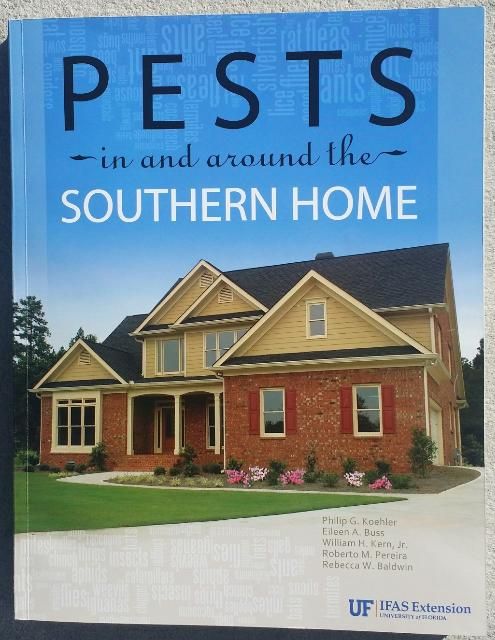
Pillbugs and Sowbugs
Pillbugs (Figure 1) and sowbugs (Figure 2) are common crustacea belonging to a group of animals called isopods and are found throughout the South. They are the only crustaceans that have adapted completely to terrestrial habitats. They are wingless, oval or slightly elongated arthropods about 1/2 inch (13mm) in length and slate-gray, with body segments resembling armored plates. Both pillbugs and sowbugs feed primarily on decaying organic matter, although occasionally they may damage the roots of green plants. Although their typical habitat is outdoors, they occasionally wander indoors but they do not cause damage.
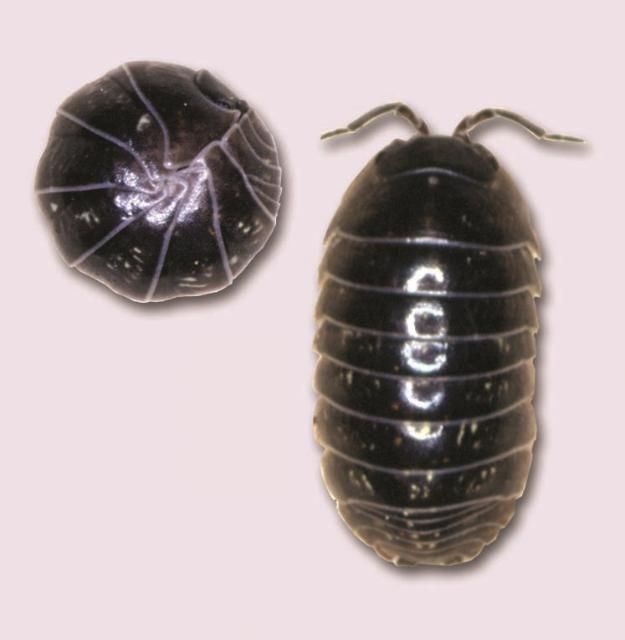

Credit: J. Castner, University of Florida
Pillbugs, or "rolly-pollies," lack tail-like appendages and can roll into a tight ball, from which the name "rolly-pollies" is derived. Sowbugs, often called woodlice, possess two tail-like appendages, seven pairs of legs, and well developed eyes. They are incapable of rolling into a tight ball.
Habits and Biology
The habits, biology, and control of sowbugs and pillbugs are similar. Both animals are slow-moving, crawling arthropods requiring high moisture, and are most active at night. When resting during the day, they may be found under trash, rocks, boards, decaying vegetation, or just beneath the soil surface. A heavy infestation indoors usually indicates a large population outdoors. Mulches, grass clippings, and leaf litter often provide the decaying organic matter they need to survive.
Breeding can occur throughout the year in Florida. The female carries the eggs in a brood pouch (marsupium) on the underside of her body. The number of eggs per brood ranges from seven to 200. The eggs hatch in three to seven weeks and the young remain in the pouch another six to seven weeks, although this time is variable because the young leave the pouch of their own accord. Once the young leave the pouch, they never return. Typically, one or two broods occur each year depending on environmental conditions. Individuals may live to be two years old.
Centipedes and Millipedes
Centipedes and millipedes are commonly seen in yards and occasionally enter homes. Neither centipedes nor millipedes damage furnishings, homes, or food. Their only importance is that of annoying or frightening individuals.
Centipedes (Figure 3) are many-legged animals (ranging from 10 to 100 depending on species) and belong to a group of animals called chilopods. They are usually brownish, flattened animals with many body segments, with most body segments having one pair of legs. Centipedes are fast runners and may vary in length from 1 to 6 inches (2.5 to 15 cm). They have one pair of antennae, or "feelers," that are easily seen. Centipedes have poorly developed eyes and are most active at night. They are active predators feeding mainly on insects and spiders. All centipedes have venom glands to immobilize their prey, but the toxicity of the venom is not enough to be lethal to humans. The jaws of the smaller local species cannot penetrate human skin; however, the larger species may inflict painful bites.
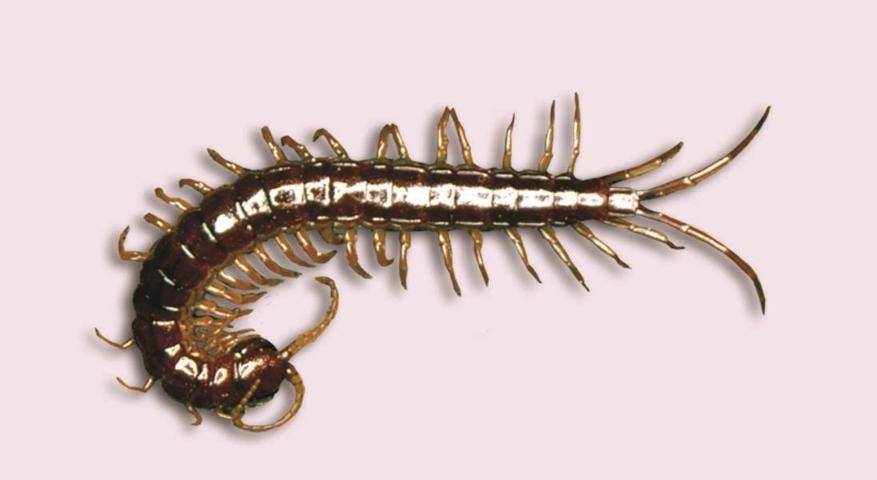
Centipedes are usually associated with damp, dark places such as under stones, leaf litter, logs, bark, or soil crevices. Indoors they may be found in closets and bathrooms where there is high humidity.
Centipedes usually lay 15 to 55 eggs clustered together in the soil, although the eggs of some species are laid singly. The eggs hatch soon after they are deposited. The female will usually guard the eggs and the newly hatched young. Young centipedes closely resemble the adults and require three years to mature. Centipedes are rather long-lived, and individuals may live up to six years.
Millipedes (Figure 4) are commonly known as "thousand leggers" and belong to a group of arthropods called diplopods. Millipedes are wormlike, cylindrical animals with many body segments, and most body segments bearing two pairs of legs. Millipedes tend to coil up tightly when disturbed, and some species can secrete a foul-smelling fluid. Millipedes feed on decaying vegetable matter and are often found under stones, flower pots, boards, or similar debris where there is abundant moisture. Occasionally after rains or during cold weather, large numbers of millipedes may migrate into buildings. They can climb foundation walls and enter homes through any small opening. These pests are generally more troublesome in wooded or newly developed areas, where decaying vegetation provides excellent food and breeding conditions.
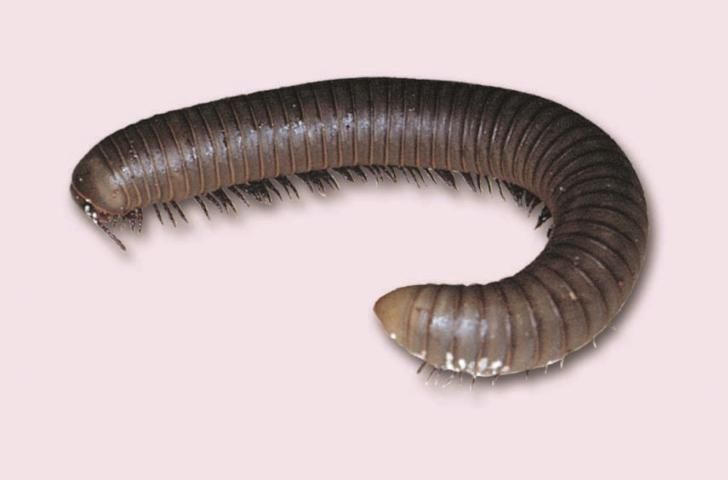
Female millipedes can lay from 20 to 300 eggs singularly or in clusters in the soil. The eggs hatch within a few weeks, and the young go through seven to eight stages before maturation to adulthood.
Earwigs
The name earwig is derived from an old superstition that these insects enter peoples' ears and bore into the brain. This idea is entirely unfounded as earwigs are harmless to man. Some species have scent glands from which they can squirt a foul-smelling liquid. This is probably used for protection; however, it makes them very unpleasant when accidentally or purposely mashed. If handled, earwigs can pinch with their pincerlike appendages.
Earwigs (Figure 5) are elongated, beetle-like insects. They are short-winged and fast-moving and typically measure about 1/2 to 1 inch (1.2-2.5 cm) in length. They are usually dark brown and possess a pair of pincerlike appendages at the tip of the abdomen. They have chewing-type mouthparts and slow development.
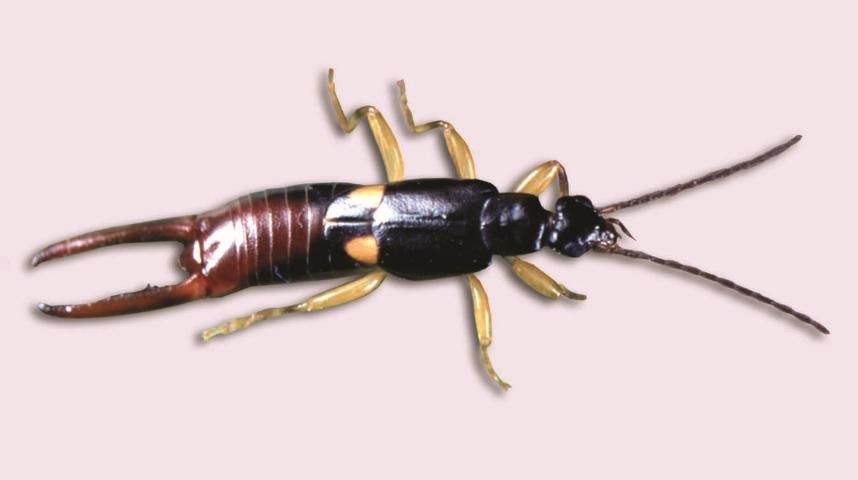
Earwigs are nocturnally active, and usually hide in cracks, crevices, under bark or in similar places during the day. They are usually scavengers in their feeding habits, but occasionally feed on plants. Some species will feed on other insects and spiders.
The striped earwig adults are dark brown with light tan markings. The males are large and robust with stout pincers. The females are somewhat smaller and lighter in color than the males. Striped earwigs are found in areas with sandy or clay soils and live in subterranean burrows or under debris. They are usually found outdoors unless populations are large or other conditions are adverse. They enter structures in search of food, a more suitable environment, or just by accidental meanderings.
Because of their nighttime activity, they remain in the soil or under debris during the day. Heavily thatched lawns or mulched flower beds are among their preferred daytime habitats. At night, they assemble in large numbers around street lights, neon lights, lighted windows, or similar locations, where they search for food. Favorite foods include armyworms, aphids, mites, and scales. They also forage on food scraps or dead insects.
The female lays about 50 tiny eggs in a subterranean burrow. The eggs hatch into nymphs in about seven days, and the nymphs feed on their egg case. The female continues to care for the young, grooming and manipulating them in the burrow throughout the first nymphal stage. The young nymphs are about 1/8 inch (3 mm) long and could be very easily confused with termites.
In about seven days, the nymphs molt into the second stage, and they are released from the burrow by the female. At this time, the female loses her maternal instincts and often will devour the nymphs before they can escape and hide. During later stages, the nymphs tend to be cannibalistic. The earwig becomes an adult after passing through six nymphal stages. The life cycle from egg to adult usually averages 56 days.
Control
Indoors
Sowbugs, pillbugs, centipedes, millipedes, and earwigs cause no damage inside the home. Simple mechanical control, such as a broom and dustpan, can be used to remove the pest from the house. A vacuum also works well in removal of these pests. If these pests become a serious nuisance, elimination of hiding places, food material, and moisture sources will reduce the infestation. Be sure to check potted plants for pest activity before bringing them indoors. Insecticides can be applied for control of these pests as crack and crevice or spot treatments to infested areas or areas where the pests enter the house.
Outdoors
A large indoor population of these pests indicates large numbers surrounding the structure. Removal of breeding sites and harborages is key to long-term control of these pests. Compost piles and decaying vegetation should be removed from areas close to the house. Mulch should be only 2 to 4 inches (5 to 10 cm) deep so it remains dry most of the time. These pests can be caught in pitfall traps, such as jars or tin cans buried at ground level, which can be baited with an appropriate food. These pests cannot easily climb the sides of the container and are trapped. The trap can be cleaned periodically, and the trapped pests destroyed.
It is sometimes necessary to control these pests with outdoor insecticide applications. These applications can be made as either barrier treatments to prevent pests from entering the house or as broadcast treatments to control pests in infested areas of the landscape. Barrier treatments are usually applied to the walls and soil immediately surrounding the house. It is typical to make barrier applications 3 feet (92 cm) up the wall and 6 feet (1.8 m) out, depending on the label. Additionally, treatments should concentrate on steps, damp areas, and cracks between sidewalks that provide guidelines for pest movement. It may also be necessary to treat mulched flowerbeds and the base of shrubbery. Chemical treatments against these pests should generally be made after elimination of the breeding sites and areas harboring the populations.